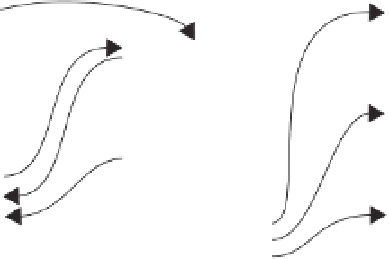Environmental Engineering Reference
In-Depth Information
Rainfal l
Rainfall excess
Crusting
Interception
Surface storage
Structural
changes
Soil erodibilit y
Roughness
Vegetation
effects
Slope
(gradient, length, form )
Water dept h
Overland
flow
Flow detachment
Rainsplash detachment
Suspended
sediment
transport
Rainsplash
transport
Unconcentrated
flow transport
Concentrated
flow transport
Rainsplash deposition
Deposition from flow
Soil eroded from hillslope
Figure 15.1
Complexities of the soil erosion process. Modified from Quinton (2004) and Wainwright
et al
. (2008a).
be applied to predict patterns of erosion over a large
spatial extent. The results of using this model, MIRSED
(Brazier
et al
., 2001a, b) are evaluated in terms of avail-
able observed data, which are also shown to be highly
variable, in space, reflecting the complexity of hillslope-
scale erosion processes and the interactions between land
use, soil type and topography that controls hillslope
erosion.
15.3 WEPP - The Water Erosion
Prediction Project
The spatially distributed, process-based Water Erosion
Prediction Project (WEPP) was initiated by the United
States Department of Agriculture (USDA) in 1985 to
succeed the USLE (Universal Soil-Loss Equation) and





















Search WWH ::

Custom Search